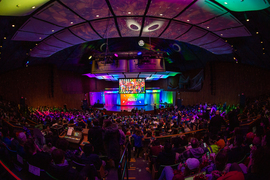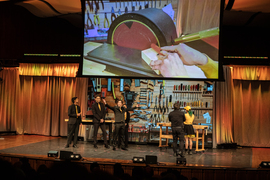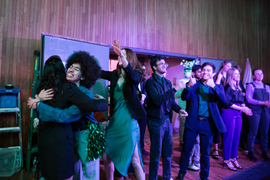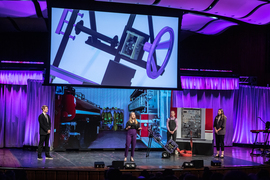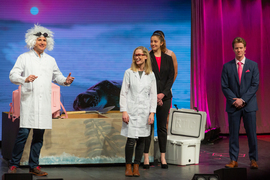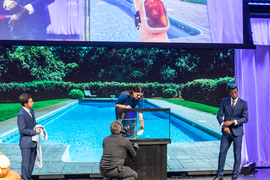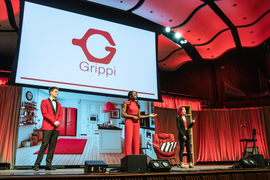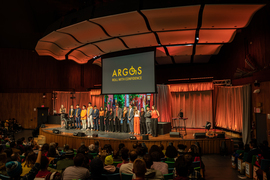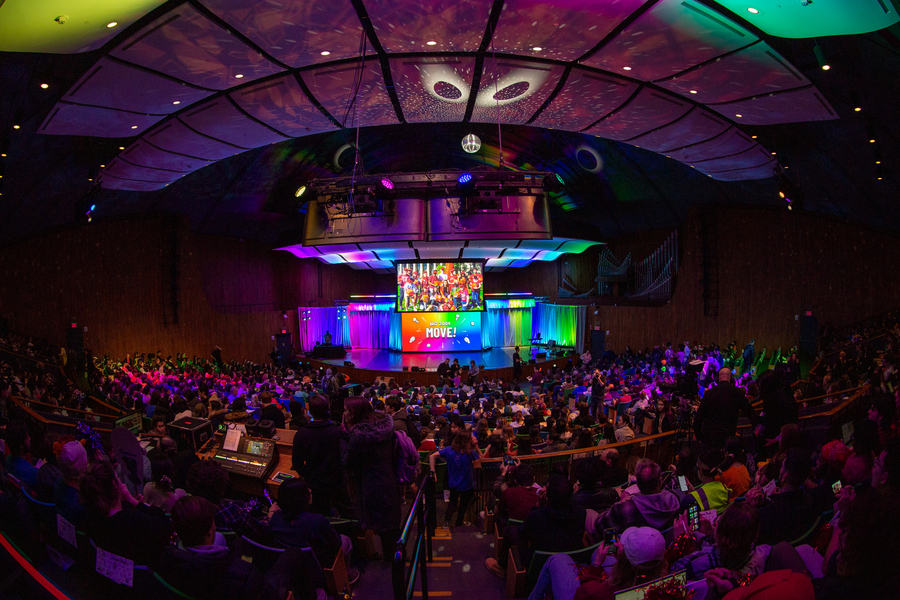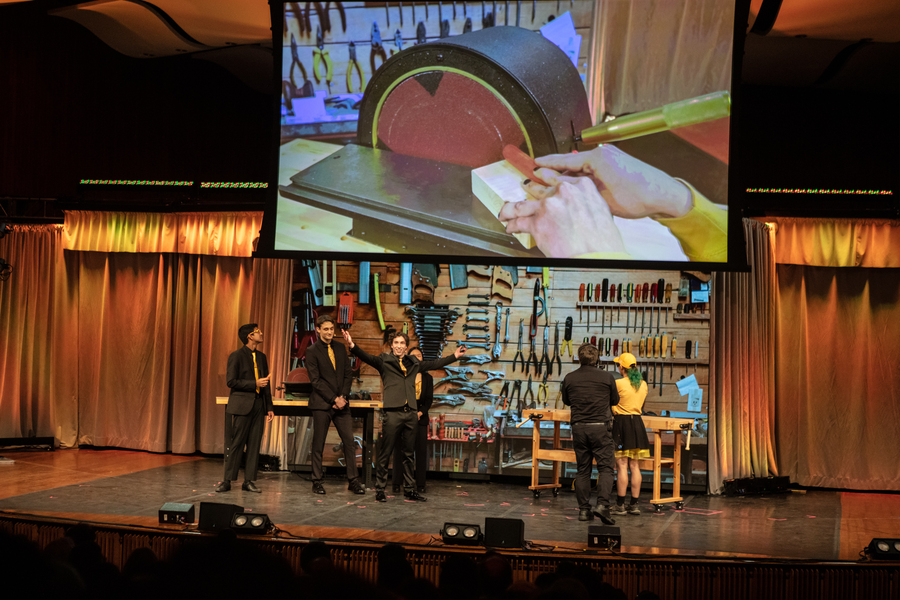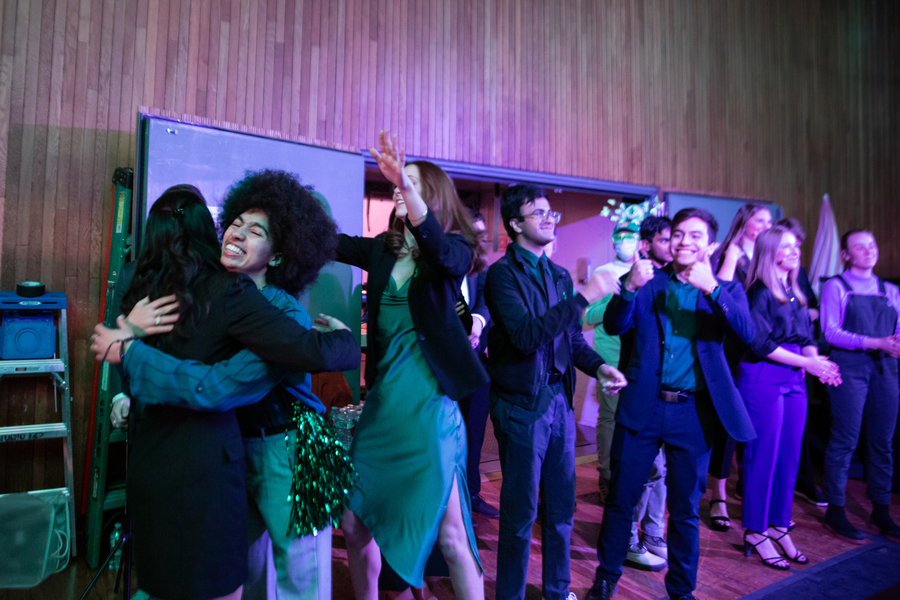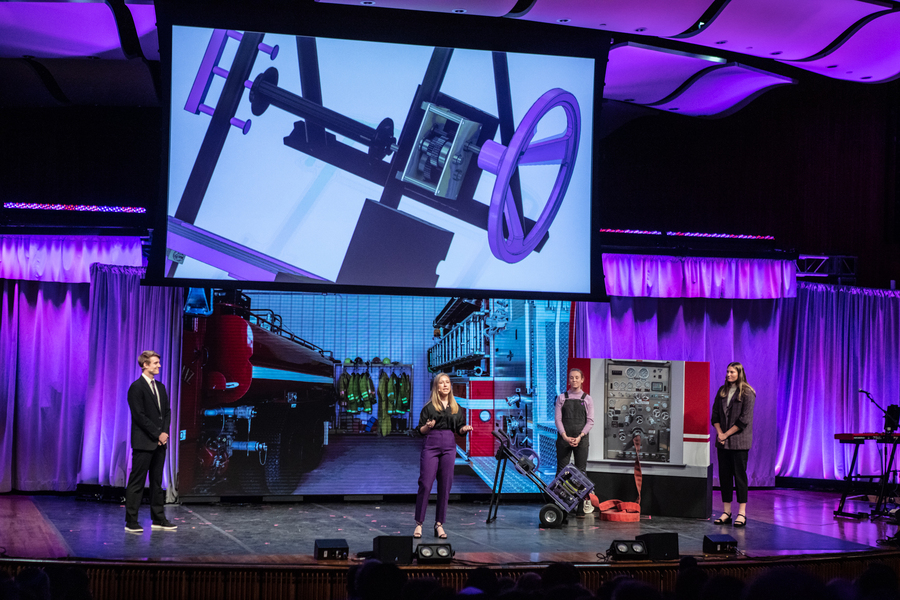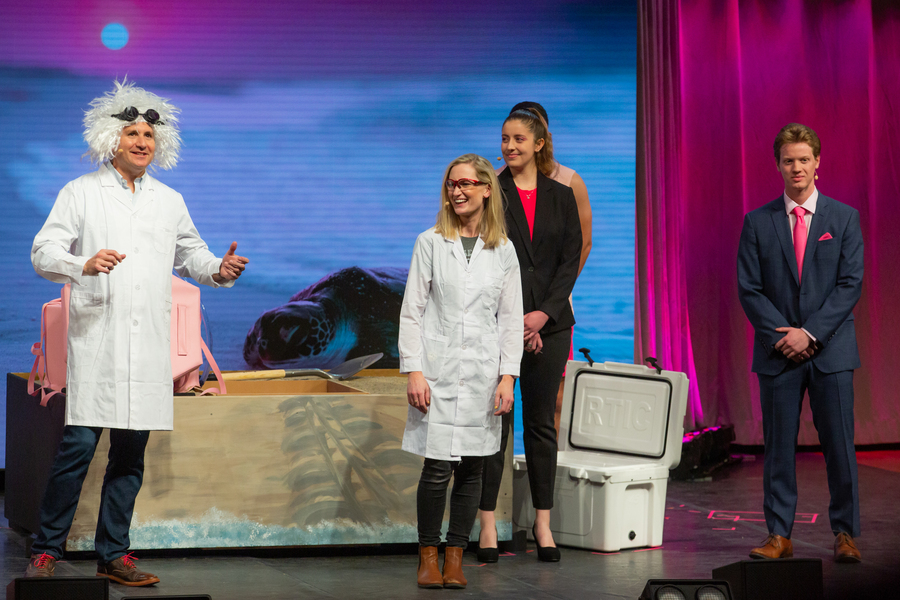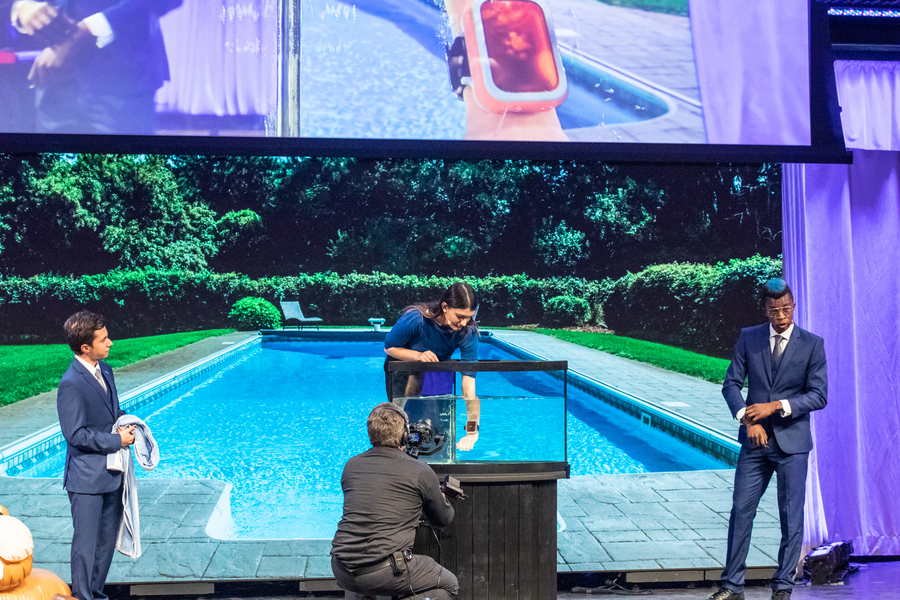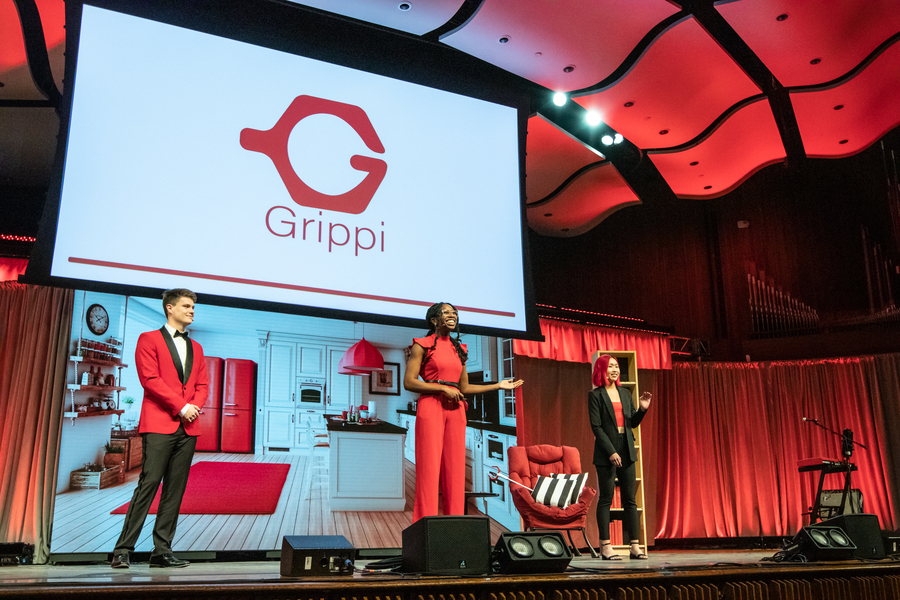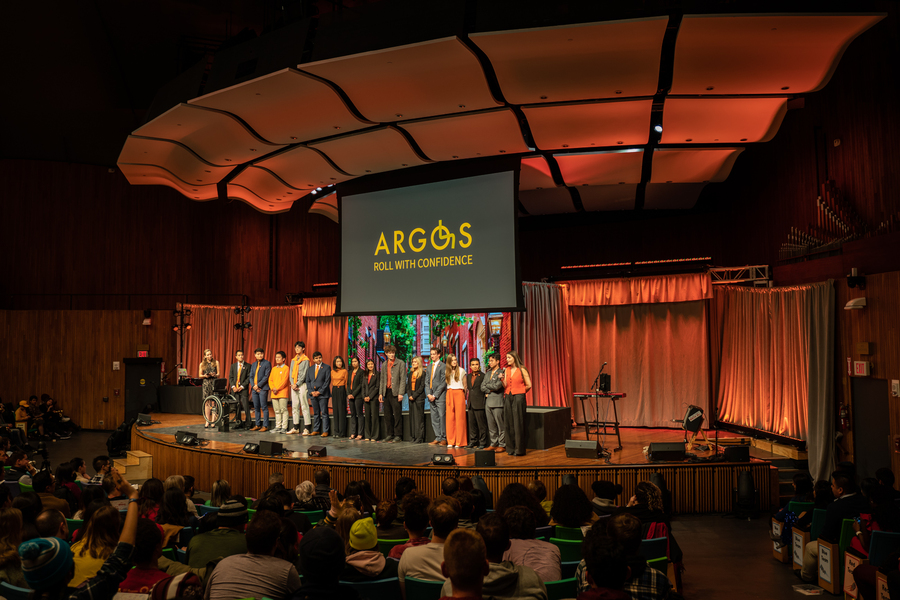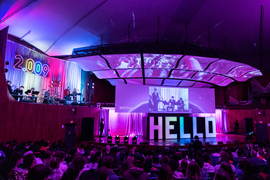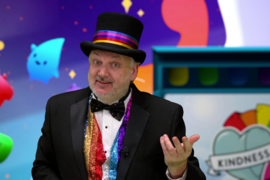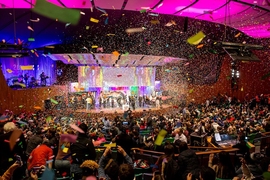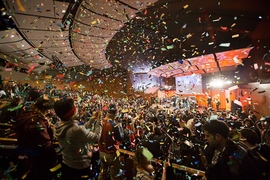On Monday evening, inside a rainbow-lit Kresge Auditorium, a capacity crowd whooped and hollered and shook their pom-poms along to one of the most anticipated shows of the year: the final student presentations of 2.009 (Product Engineering Processes).
Known on campus as “two-double-oh-nine,” the popular fall semester course challenges teams of undergraduates over three months to design, build, and draft a business plan for a product prototype, which they then demo and pitch in front of a live audience, on MIT’s largest stage.
This year, students worked in one of seven teams, each represented by a color of the rainbow. Teams were given $7,500, which they could put toward building, testing, and presenting their final prototype. This year’s design theme, “Move!” inspired a kaleidoscope of ideas, including a self-spooling firehose cleaner, a swim safety wristband for kids, and a speed control for manual wheelchairs.
At Monday’s prototype launch event, teams took the stage one at a time, pitching their products against elaborate backdrops and props tailored to showcase each prototype. Between presentations, the audience was treated to musical interludes by mechanical engineering students and staff, the Mocha Moves dance troupe, and the a capella group Resonance.
In the spirit of this year’s theme, brief videos highlighted students reflecting on the question, “What moves you?” Many voiced common themes, including “family and friends,” “creating new things,” “pushing what’s possible,” and the desire to “make the world a little better.”
As teams pitched to a full Kresge audience, over 4,500 viewers watched the show live online. The evening’s events were emceed by course co-instructors Ellen Roche, associate professor of mechanical engineering at MIT, and Josh Wiesman, professor of entrepreneurship at Tufts University. Both Roche and Wiesman took over from professor of mechanical engineering David Wallace, who is on sabbatical this year and has taught 2.009 since 1995.
Following Wallace’s lead (and his signature top hat and tails), Roche and Wiesman donned multiple costumes as accents for each product as they introduced teams to the stage through the night.
“It takes a uniquely amazing person to take a product from concept to finished prototype in only three months,” Wiesman said as he addressed both the audience and the students. “The majority of consumers only ever interact with the shiny finished product. They never see the blood, the sweat, and the tears that went into your hard work and designs. But it’s this process you went through that will help you create the next game-changing product tomorrow.”
Saving fingers, fashion, and fire
The evening’s first pitch came from the Gold Team, with a demonstration of SandStill, a design for a safer benchtop disc sander. Students pointed out that more than 1,500 sander-related injuries occur in the United States each year. To drive home this point, one team member attempted to run a wood block through a traditional disc sander set up onstage. Using a hot dog as a stand-in for his finger, the student ran the meat too close to the blade, with devastating results for the wiener that drew delighted gasps from the crowd.
As a counterpoint, another team member played out the same scenario with the team’s SandStill prototype, set up next to the traditional sander. This time, when running a hot dog too close to the blade, the sander instantly stopped, before any damage was done. The key to the design is a second, lighter disc that spins next to the traditional heavy sanding disc and stops instantly when a touch sensor is activated. The team plans to partner with makerspaces and eventually sell the sander to hobbyists and industrial shops.
Moving from the workbench to the runway, the second pitch was presented by the Green Team, who rolled onstage with Figure, a design for a portable, packable mannequin. While traditional mannequins are monolith structures that are bulky to transport, the team’s prototype can collapse like an accordion and fit into a space as small as a carry-on suitcase.
The prototype resembles a traditional mannequin in form and firmness, and includes an outer covering onto which tailors can pin garments. This covering can be unzipped and folded up. The underlying structure, made from concentric metal rings held together with Kevlar strings, can then be collapsed, as can the telescoping stand that displays the mannequin. The team envisions the design could be useful for fashion designers, cosplayers, and costume designers who are also frequent travelers.
The Purple Team was next onstage with Hydros, a prototype for a self-spooling firehose cleaner. The product is designed to help firefighters after a fire, once they return to the station and have to clean their equipment. Firefighters typically use brooms and water to wash off hoses, which can expose them to toxic chemicals. The students’ solution is designed to feed a firehose through a cleaning system powered by a fire truck’s water.
The prototype resembles a large box on a dolly. Circular brushes, water, and soap nozzles are set inside the box, while the outside includes detergent and a water hookup that attaches to a fire truck. Just above the box is a wheel that can be turned to pull a firehose up through the cleaning box, then around a spool, which can then be removed to return the clean hose to the truck. Though a firehose can weigh up to 100 pounds, the force needed to turn the wheel is comparable to turning a car steering wheel, thanks to the team’s gear system. The team hopes its prototype will reduce firefighters’ contact with cancer-causing residue.
The right balance
With its prototype, the Pink Team aimed to serve two consumers: conservationists and the animals they are helping to save. The team’s product, Ashore, is a sand incubator that is designed to rebalance the gender ratio of sea turtles. Sea turtle eggs that incubate in hotter sand tend to produce more females than males. With climate change, sea turtle populations have tipped heavily female, which has already proven a “catastrophic” imbalance in several turtle species.
The team’s prototype is a temperature-controlled incubator that resembles a soft, hexagonal lidded box, the inside of which is padded and insulated like a cooler. In turtle hatching season, conservationists would retrieve a cache of eggs and carefully place them in the cooler, cover the lid, and bury the box in the sand. A tube running up out of the box can be threaded to the surface, where it could attach to a water pump that delivers cool water to the box’s outer layer, keeping the eggs at temperatures more likely to produce males. The team hopes to partner with conservation groups in Florida, where more than 65,000 sea turtle nests are laid each year.
Keeping with the aquatic theme, the Blue Team presented SpOtter, a prototype for a personal swim safety alert for kids. They opened with a startling statistic: Nearly two-thirds of fatal child pool drownings occur in backyard pools. More troubling still: Most pool drownings are silent, as children lack the air to call out for help.
Enter SpOtter — a waterproof device that resembles an oversized wristwatch. The face of the watch is a small colorful box that magnetically attaches to the wristband. If in distress, a child can quickly pull the box off, which then bobs to the surface and emits a bright light and a loud beeping alert. The team showed a video of a child volunteer demonstrating the device while swimming in a pool. The team says that with proper instruction for both kids and adults, SpOtter could help prevent accidental drownings in the 10.4 million backyard pools across the U.S.
Get a grip, on a roll
The Red Team chose to revamp a tool that is used, often with frustration, by the elderly: the gripper. Conventional long-handled, claw-like grippers require users to maintain a constant hand pressure. But many elderly people, and those with muscle disorders, are unable to keep a tight and constant grip. The team’s prototype, Grippi, aims to take the pressure off, with a battery-powered, spring-loaded design.
The gripper’s pistol-like handle includes a button a user can press to control the opening and closing of the claw. The handle’s spring-loaded design enables the claw to maintain a constant grip around an object, without the need to apply extra pressure. The outside of the claw has adhesive and magnets, which also can be used to retrieve objects. Team members onstage demonstrated using Grippi to pick up keys and a dollar bill from the floor and a coffee mug from a high shelf. The team hopes that Grippi can help assist the more than 3 million people in the U.S. who experience weak grip strength.
The final pitch of the night came from the Orange Team, which presented Argos, a speed control for manual wheelchairs. The team opened with an observation: “Sometimes, life moves us downhill a little too quickly.” To make their point, students set up a long ramp with a 5-degree incline. From the top of the ramp, a team member rode a manual wheelchair down the slope, picking up speed before using her hands to slow the chair’s wheels near the bottom.
After talking with wheelchair users, the team realized that controlling a chair down a slope can be difficult and scary. To restore users’ confidence, the team’s product is designed as a sort of wheelchair cruise control. The device attaches to a chair’s wheels and uses a closed-loop feedback of speed sensing and braking to control the speed of a chair downhill. In tests, the students found Argos kept a chair rolling downhill at 2.5 miles per hour; without the attachment, the chair rolled at double the speed. The team hopes the attachment can help millions of wheelchair users “roll with confidence.”
In closing, Roche and Wiesman thanked the many people behind the scenes, including lab instructors, teaching assistants, staff members, technicians, mentors, and those who worked to produce the night’s show. Finally, they thanked the students.
“Without designers like you, and your grit, perseverance, passion, collaboration, and never-quit energy, we would have no products, no medical devices, no consumer packaged goods,” Roche said as she addressed the students. “We hope you will take the experience of 2.009 with you forward in your careers, and have a newfound respect and appreciation for what it takes to create a truly impactful product.”
